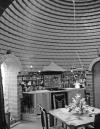Resumen
En el Instituto de Construcciones Experimentales de la Universidadde Kassel fue desarrollada una técnica para construircúpulas de adobe con gran dimensión sin encofrado. La sección delas cúpulas es optimizada por un programa de computadora paraevitar fuerzas de anillo. Para construir estas cúpulas fácilmente ycon mucha precisión fue desarrollada una guía rotatoria, pudiéndoseasí construir cúpulas de hasta 13 m de diámetro y solo 30cm de espesor de muro. Para optimizar la acústica de la cúpulafue desarrollada una forma de adobe “acústico”, que favorece ladistribución y absorción del sonido. Se muestra la primera cúpularealizada en América Latina de este tipo, que fue construida en La Paz, Bolivia en 2000, con un diámetro de 8,8 m y la primera cúpulacon techo verde en América, construida en Brasil, con un diámetrode 9 m. La cúpula más grande de adobe de este tipo con 11 m deluz y 7 m de altura fue construida en Alemania. Se muestran otrosejemplos de cúpulas de adobe construidas sin encofrado para viviendas en Alemania. Los proyectos realizados muestran que las cúpulas de adobe con techos verdes producen un ambiente interiormuy confortable tanto en climas cálidos como templados o fríos.Mediciones realizadas dieron como resultado que los techos verdesevitan la entrada del calor en verano y del frío en invierno, por lo quese produce un considerable ahorro energético. Además, tambiénse midió que el barro equilibra la humedad en ambientes cerrados.Asimismo, la cúpula de La Paz mostró que se puede construir unacúpula sismorresistente con este sistema.La revista Apuntes se encuentra registrada bajo la licencia Creative Commons Reconocimiento 4.0 Internacional. Por lo tanto, esta obra se puede reproducir, distribuir y comunicar públicamente en formato digital, siempre que se reconozca el nombre de los autores y a la Pontificia Universidad Javeriana. Se permite citar, adaptar, transformar, autoarchivar, republicar y crear a partir del material, para cualquier finalidad (incluso comercial), siempre que se reconozca adecuadamente la autoría, se proporcione un enlace a la obra original y se indique si se han realizado cambios. La Pontificia Universidad Javeriana no retiene los derechos sobre las obras publicadas y los contenidos son responsabilidad exclusiva de los autores, quienes conservan sus derechos morales, intelectuales, de privacidad y publicidad.
El aval sobre la intervención de la obra (revisión, corrección de estilo, traducción, diagramación) y su posterior divulgación se otorga mediante una licencia de uso y no a través de una cesión de derechos, lo que representa que la revista y la Pontificia Universidad Javeriana se eximen de cualquier responsabilidad que se pueda derivar de una mala práctica ética por parte de los autores. En consecuencia de la protección brindada por la licencia de uso, la revista no se encuentra en la obligación de publicar retractaciones o modificar la información ya publicada, a no ser que la errata surja del proceso de gestión editorial. La publicación de contenidos en esta revista no representa regalías para los contribuyentes.


